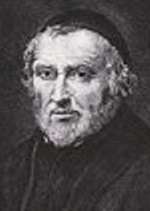Godfrey Henschen

Godfrey Henschen (also Henskens or Henschenius in Latin), 21 June 1601 – 11 September 1681, was a Belgian Jesuit hagiographer, one of the first Bollandists.[1]
Life
Henschen was born at Venray, Limburg, in the Low countries. He was the son of Henry Henschen, a cloth merchant, and Sibylla Pauwels. He studied the humanities at the Jesuit college of Bois-le-Duc (today the town of 's-Hertogenbosch) and entered the novitiate of the Society of Jesus at Mechlin on 22 October 1619. He taught successively Greek, poetry and rhetoric at Bergues, Bailleul, Ypres, and Ghent. He was ordained a priest on 16 April 1634, sent to the professed house at Antwerp the following year, and admitted to the profession of the four Jesuit vows on 12 May 1636.
Career
Henschen had been a pupil of Jean Bolland. From the time of his arrival in the city he was associated as a collaborator with Bolland, who was then preparing the first volumes of the Acta Sanctorum. Bolland had asked for an assistant, a request supported by the abbot of Liessies Abbey, Antoine de Wynghe. In 1635 Henschen was assigned to start work on the February saints, while Bolland gave himself to the preparing the material for January. It was Henschen who, by his commentary on the Acts of St. Amand, suggested to Bolland the course to follow, and gave to the work undertaken by his mentor its definitive form. After fourteen years of work, the two volumes for January were printed in Antwerp in 1643 and greeted with enthusiasm by scholars.[2]
Work on the January volume was done in two garrets where Bolland kept his papers and books. As climbing the steep steps began to prove difficult, he asked for and obtained the use of a vacant room on the second floor, which later became the Bollandist Museum.[2] The three volumes for February were released in 1658,[3] and was equally well received.[2]
In 1660, at Bolland's direction, Henschen and Daniel van Papenbroek journeyed to Rome collecting ancient documents for their studies along the way. They stayed in Rome for nine months and returned by way of France[4] (22 July 1660 – 21 December 1662). Upon their return, they learned that Bolland had died, at which point he and Papenbroek began to lead the project. He was the first librarian of the Museum Bollandianum at Antwerp.
Henschen continued to work on the Acta Sanctorum up to the time of his death.
In total Henschen collaborated on the volumes for January, February, March, and April, and on the first six volumes for May, that is on seventeen volumes of the Acta Sanctorum. Several of his posthumous commentaries appeared in the succeeding volumes. A list of some other works from his pen will be found in Augustin de Backer's Bibliothèque des escrivains de la Compagnie de Jésus.
He died at Antwerp, aged 80, in 1681.
References
- ↑
 Herbermann, Charles, ed. (1913). "Godfrey Henschen". Catholic Encyclopedia. New York: Robert Appleton Company.
Herbermann, Charles, ed. (1913). "Godfrey Henschen". Catholic Encyclopedia. New York: Robert Appleton Company. - 1 2 3 Delahaye, Hippolyte S.J., The Work of the Bollandists, Princeton University Press 1922
- ↑ "Jean Bolland, founder of the Bollandists", The Jesuits of the Province of Southern Belgium and Luxembourg
- ↑ "The Kalendars of the Church", The Christian Remembrancer, Vol. XL (July-December), J. & C. Mozley, London, 1865
Sources
- Daniel van Papenbroek, De vitâ, operibus, et virtutibus God. Henschenii in Acta Sanctorum, VII, May
- Joannes Joseph Habets, Godfried Henschenius medestichter der Acta Sanctorum (Maastricht, 1868).
- Delehaye, Hippolyte. The work of the Bollandists through three centuries (1615-1915), Brussels, Society of Bollandists, 1959
- Attribution
![]() This article incorporates text from a publication now in the public domain: Herbermann, Charles, ed. (1913). "Godfrey Henschen". Catholic Encyclopedia. New York: Robert Appleton.
This article incorporates text from a publication now in the public domain: Herbermann, Charles, ed. (1913). "Godfrey Henschen". Catholic Encyclopedia. New York: Robert Appleton.